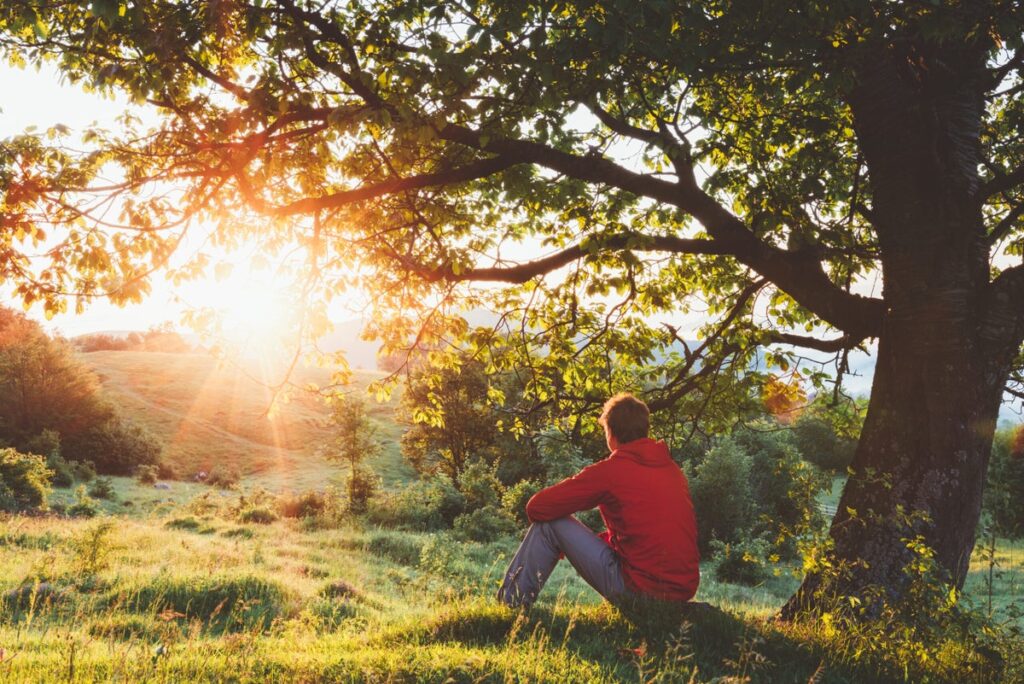Heading out the door? Read this article on the new Outside+ app available now on iOS devices for members! <a href="https://outsideapp.onelink.me/wOhi/6wh1kbvw" class="o-content-cta-link" data-analytics-event="click" data-analytics-data="{"name":"Element Clicked","props":{"destination_url":"https://outsideapp.onelink.me/wOhi/6wh1kbvw","domain":"<>","name":"in-content-cta","type":"link"}}”>Download the app.
If you’re reading this article, it’s safe to assume you’re not in a cave somewhere where your only concern is meditating and doing yoga. Living in the world—and being a part of it—comes with a lot of responsibilities, a lot of obligations, and a lot of opportunities to split our attention.
Except that, according to current research, our attention can’t be divided. Multitasking does not actually exist. Neuroimaging shows that our brains can only do one thing at a time. What we perceive as doing several things simultaneously, is in fact rapidly task-switching—our awareness is bouncing back and forth between each task. No wonder we feel spread so thin and exhausted all the time!
Yoga is an anchoring tool. Moving the body and working with the breath provide two real-time pathways for us to tune into. Getting aligned in a posture can be its own form of meditation, as it gives the mind something to focus on. In this sequence, we’ll take a grounding approach to our favorite and most familiar poses–and take our time getting into them so that you complete the practice feeling rooted and present.
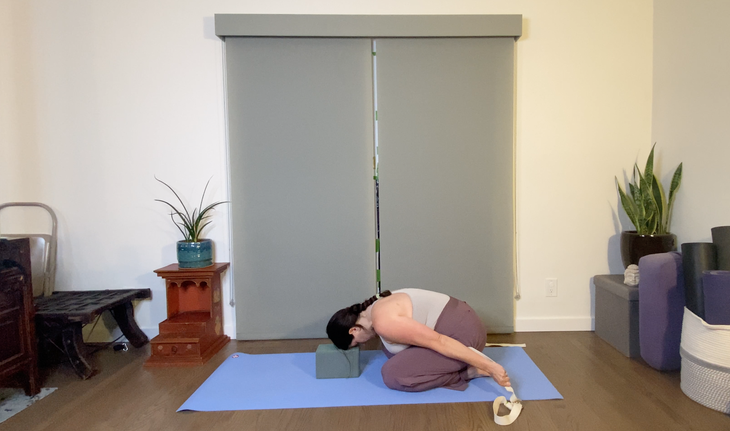
1. Balasana (Child’s pose)
Think of the phrases we use to describe feeling ungrounded: “scattered,” “out of your body,” “head in the clouds.” Each of these implies a lack of ground beneath you, so the best thing to do when you are feeling that way is connect with the earth. It can be as simple as stepping outside barefoot, stopping to touch a tree, or tending to a houseplant. In this case we’ll placing a strap over the thighs emphasizes the heaviness we are trying to evoke.
How to: Come to your knees and place a strap across the top of your thighs at your hip joint. Holding the strap ends in each hand, lower your hips,and fold into Child’s Pose. As you sink your hips back toward your heels, press the strap back toward your bum and down toward the floor. You can keep holding the strap for the duration or let it go. Stay for twenty breaths. When it is time to come out, press up to your hands and knees and place the strap off to the side.

2. Marjaryasana/Bitilasana (Cat/Cow), variation
When we are maneuvering through floor poses, it helps to do so from a solid foundation. Lowering to our forearms in Cat/Cow offers us more real estate on the floor and keeps us symbolically closer to the earth. It’s also a great way to get a deeper stretch in our upper back, especially that space between the shoulder blades that gets tight when we are overcommitted and overwhelmed.
How to: From Tabletop, lower onto your forearms, aligning your elbows under your shoulders. Separate your forearms shoulder-width and firmly press your hands into the floor. Make sure your knees are below your hips. On an inhalation, draw your chest through your upper arms and create a back-bend shape to come into Cow. On an exhale, ground the forearms into the earth and spread your shoulder blades to curve your back the opposite way. Continue for eight rounds, moving slowly and pressing into the floor as a way to initiate the movement.

3. Low lunge variation
This variation of low lunge is helpful for opening up the hips and psoas system, which tenses up when we are under stress. Even though we are no longer technically touching the ground when we use blocks and other props, it is no less grounding to have those supports. If anything, the props simply bring the floor up to us and help us feel more stable in a pose.
How to: In Tabletop, inhale and extend your left leg back behind you, keeping your back knee down. (Pad it with blankets for comfort.) On an exhalation, press strongly into the floor and step your right foot toward the front of your mat. If your foot doesn’t make it all the way, use your hand to bring it forward so that your knee is aligned over your heel. Bring both hands to the inside of your right foot. Lower onto your forearms, either propped up on blocks or all the way to the floor. Allow your head to hang, so your upper back will round slightly. Stay here and breathe for ten breaths. Come back to Tabletop and repeat on the opposite side.
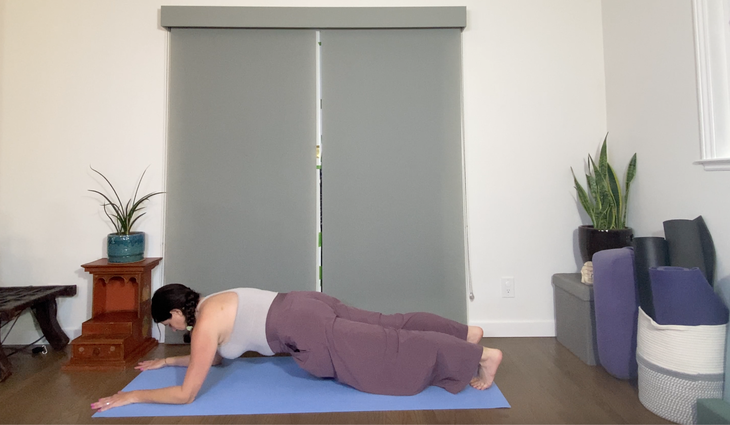
4. Forearm Plank
Grounding is not just about being heavy and staying low. We can also use our “roots” to rise. Our foundation–whether we are pressing into our feet, shins, thighs, pelvis, forearms, or hands–can provide a launch pad for the rest of our body. It is through their contact with the floor that we can create more physical space and strength.
How to: From Tabletop, lower onto your forearms aligning your elbows under your shoulders. Then step both feet back, toes curled under, to come into Plank Pose. You may keep your legs straight or bring your knees to the ground behind your hips. Press your forearms down and observe the lift that translates throughout your body. Keep your legs engaged to help support your upper body. Stay here and breathe for ten breaths. Consider moving through Downward Facing Dog and maybe taking a vinyasa before coming to your knees and preparing for your next pose.
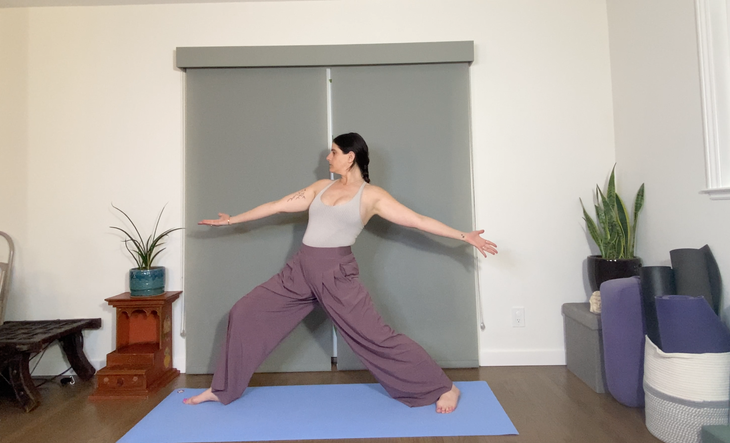
5. Virabhadrasana 2 (Warrior 2 Pose)
We don’t need to feel like we have to be cemented in place in order to connect with a sense of groundedness. Grounding can include movement, too. We just learn to do so from a more connected and present space. Introducing some dynamic movement to this low-to-the-earth, knee-down variation of Warrior 2, will help us accomplish just that.
How to: From Tabletop, step your right foot between your hands, step your left food back, and turn your toes out to the left. Windmill yourself up to standing and open to the left so your torso is facing the long side of the mat. Inhale and lift your arms out to the sides. Pause and exhale. Now, moving with your breath, inhale and reach your right arm to the right and lean your torso toward your right knee. On an exhalation, reach your left arm back and lean back over your hips. Do this five times, focusing on the support of your legs. After your last round, bring your hands back to the floor on each side of your front and return to Tabletop or pass through Downward Facing Dog, before setting to repeat the pose on the opposite side.
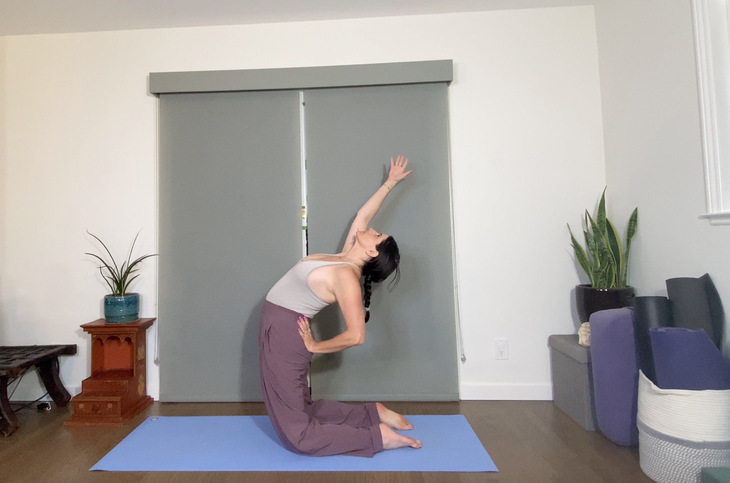
6. Ustrasana (Camel Pose), variation
There is an energetic exposure that happens when we reveal ourselves to another. We can better engage with these moments of vulnerability when we are emotionally grounded. We experience vulnerability in our bodies when we practice backbends. In spinal extension, our vital organs are exposed as we drop back into the unknown. Whether we are in an emotionally or physically vulnerable place, starting from a centered space allows us to hold ourselves with confidence.
How to: Start on your knees and stand up onto your shins with your feet and legs hip-width apart. Bring your hands to your sacrum and the back of the pelvis. Before you backbend, really commit to feeling your shins and the tops of your feet on the ground. Press down into that foundation as you lift through the chest. On an exhalation, arch back to come into Camel Pose. Keep your left hand on your lower back and inhale as you bring your right arm forward and up in line with your ear. Stay for a breath then lower your arm and bring it back to your sacrum. Repeat on the left side. Go back and forth between the arms and maybe even catch a moment where neither hand is on your back and you’re fully supported by your legs. After five rounds, inhale and bring yourself up to standing on your knees. Sit back on your heels and pause.
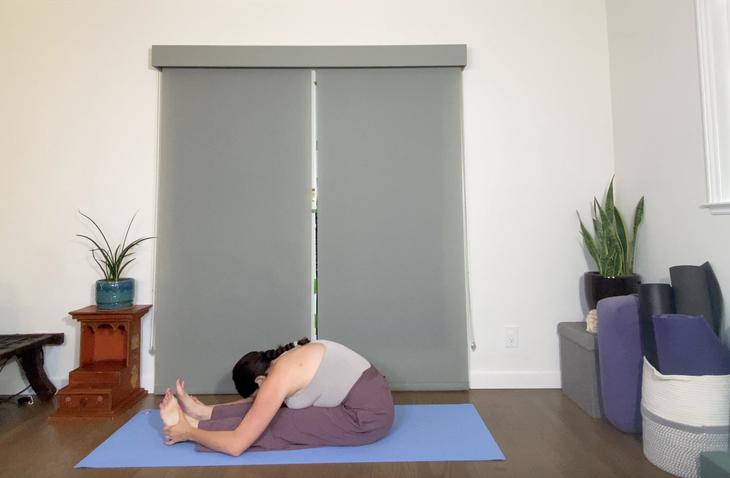
7. Paschimottanasana (Seated Forward Fold)
Folding in upon ourselves while seated on the floor may be one of the most grounding things we can do. Not only are we on the earth and drawing up from that solid energy with the backs of our legs and our seat, but then we are also bowing toward it.
How to: Come to a seated position and stretch your legs out in front of you. If your back tends to round or you otherwise have a challenging time sitting upright in this position, place a folded blanket under your sit bones. On an inhalation, reach your arms up; as you exhale, fold forward to bring your torso over your legs. Prioritize a long spine and straight back. This means you may be propped up on your arms the whole time with your chest reaching forward, or you may be able to grab your shins or feet and rest your tummy on your legs. Listen to what you need. There is nothing grounding about straining. Stay here for ten long breaths. On the last inhalation, lift your trunk away from your legs and sit up.
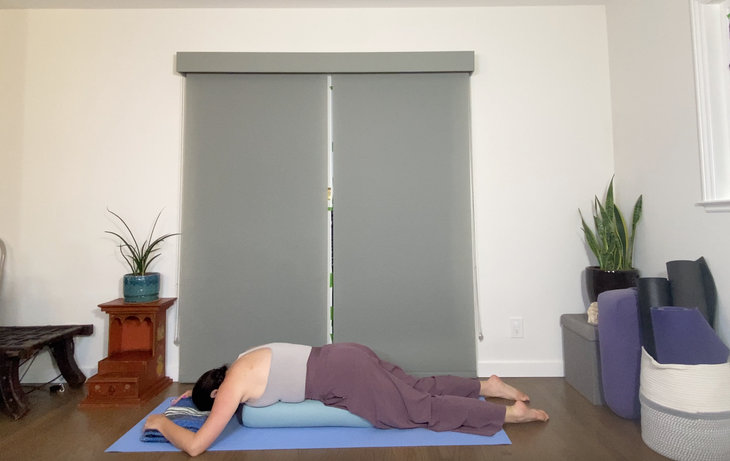
8. Prone Savasana
Before we finish our practice and return to all our responsibilities and to-do’s, let’s savor the inward nature of this sequence by really cocooning ourselves in Savasana. This finishing posture is traditionally done with our back on the earth. In this version, we’ll lie on our front body, supported by a bolster or blankets so we can find a feeling of sinking as we rest.
How to: Grab a bolster or a thick stack of blankets and place it vertically down the center of your mat. Fold a blanket near the top of the mat for your forehead. Kneel toward the back of your mat and lie on the bolster so that it runs the length of your ribcage to your top thighs. Adjust the blanket to an appropriate height and width so you have space to breathe and it feels restful. Extend your legs behind you and allow them to relax open. Remain for five to seven minutes—or more if you’re able. When you are ready to come out of the pose, press back through Child’s pose for a few moments before coming up to sitting.
Now, choose what is most deserving of your attention.


